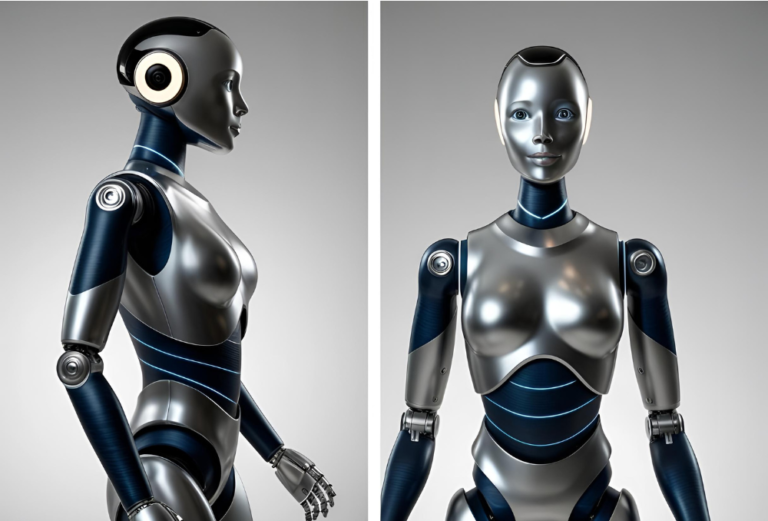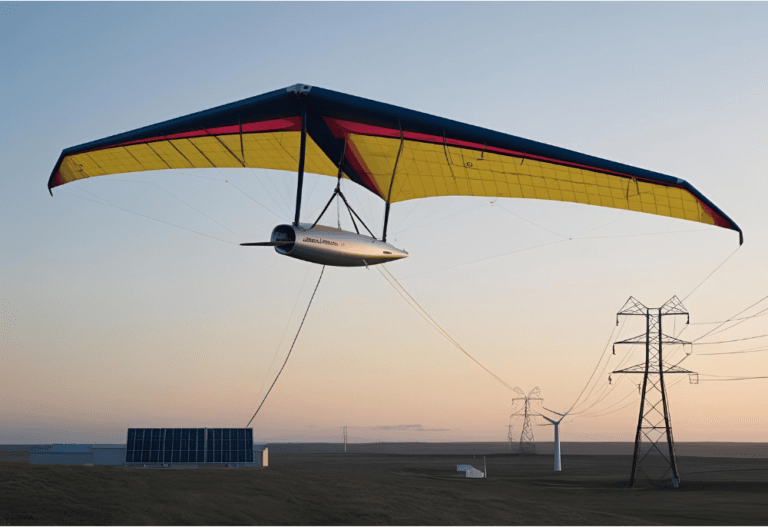Introduction: Evolution of Artificial Compound Lenses
The world of robotics is on the cusp of a revolution, drawing inspiration from some of the simplest yet most sophisticated creatures on Earth—insects. These tiny creatures, with their complex visual systems, have long fascinated scientists and engineers. The incredible visual acuity and panoramic field of view seen in insects have provided a model for technological advancements that could reshape the future of robotics and technology. This blog delves into the groundbreaking innovations in artificial compound eyes, exploring their design challenges and their potential to transform how we interact with technology.

Explore how insect vision inspires artificial compound lenses and UV polymerization in optics, transforming robotics and technology.
Understanding Natural Compound Eyes (Insect Vision)
Biological Model Overview
To fully appreciate the advancements in artificial compound eyes, it’s crucial to first understand how natural compound eyes function. Insects such as flies, bees, and mosquitoes possess compound eyes that are marvels of biological engineering. Each compound eye is made up of numerous individual lenses, called ommatidia, which together create a panoramic field of view.
How Compound Eyes Work in Insects?
Compound eyes are composed of multiple facets or ommatidia, each functioning as a miniaturized eye that captures a small segment of the visual field. This arrangement allows insects to collect a wide array of visual information simultaneously. The compound eye’s lenses work together to create a composite image with an extensive field of view. This visual system is particularly advantageous for detecting predators and prey without the need for head movement. The image processing that occurs in the insect’s brain stitches these individual visual segments into a coherent picture, providing a broad and detailed view of the surroundings.
Peripheral Insect Vision
One of the most remarkable features of compound eyes is their ability to provide almost complete peripheral vision. Unlike humans, who rely on head and eye movements to scan their environment, insects can see nearly 360 degrees around them. This wide field of view is crucial for survival in their natural habitats, where detecting movement quickly can be the difference between life and death. For instance, a fly’s ability to detect a swatting hand from almost any angle helps it evade capture, demonstrating the evolutionary advantage of such a visual system.
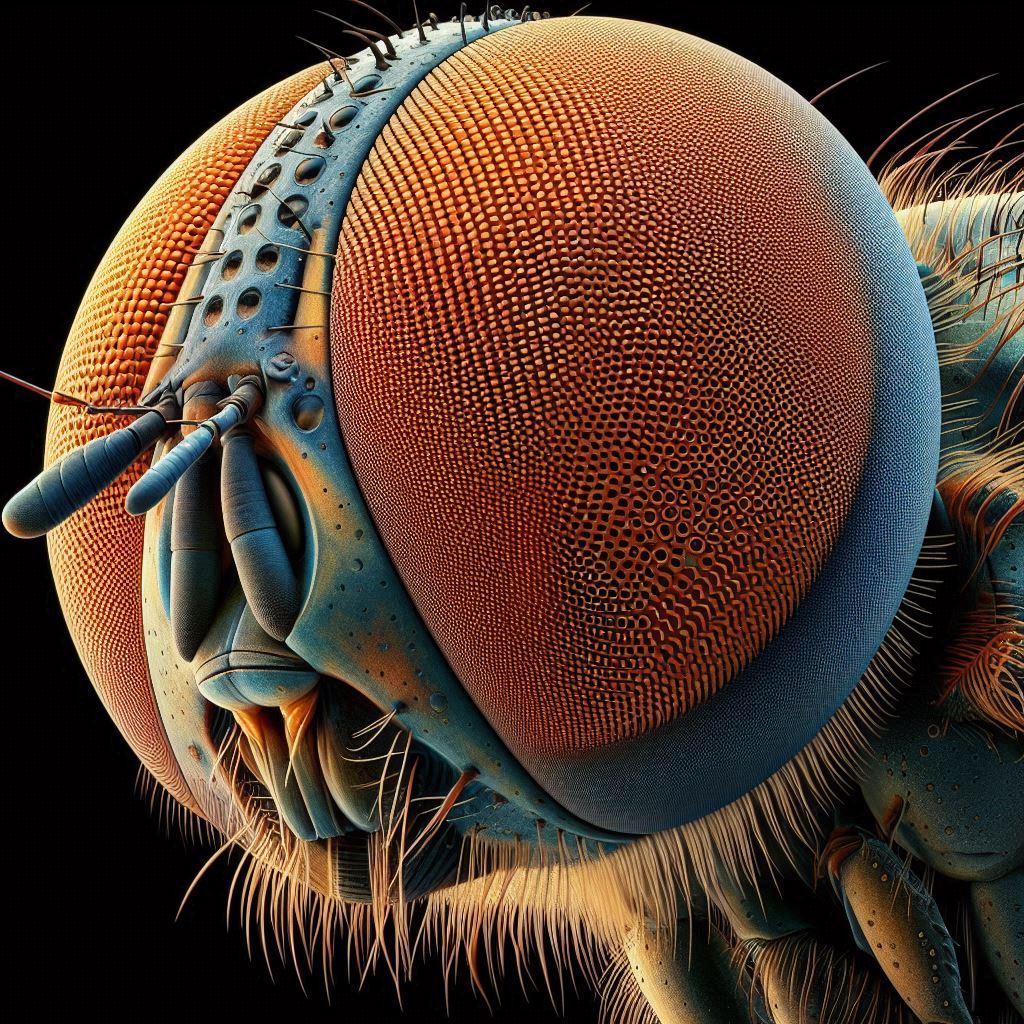
Energy Efficiency
From an evolutionary perspective, the design of compound eyes offers significant energy efficiency. Insects do not need to move their heads or eyes to scan their surroundings, which conserves energy. This efficiency results from the compound eye’s ability to cover a large visual field with minimal movement. This trait not only benefits insect vision but also serves as an inspiration for developing technologies that aim to achieve similar energy efficiency and wide-angle vision. The compact and effective design of compound eyes has driven innovations in robotics and imaging technologies, illustrating how nature’s solutions can inspire technological breakthroughs.
The Challenge of Mimicking Nature
Complexity in Design
Replicating the intricate design of natural compound eyes presents several challenges. The primary difficulty lies in accurately mimicking the curved surface and the multiple lenses of natural compound eyes. Insects’ compound eyes are comprised of thousands of tiny lenses arranged in a dome shape, each with precise alignment to capture light and provide a comprehensive visual field. Reproducing this arrangement in artificial systems requires advanced engineering techniques and materials to achieve the same functionality.
Precision and Alignment
Precision in design is crucial when creating artificial compound Lenses (eyes). The alignment of photoreceptive components must be exact to ensure that the visual information captured by each lens integrates seamlessly. Any misalignment can result in distorted or incomplete images, which can affect the performance of the artificial eye. Engineers and researchers must overcome these challenges by developing innovative fabrication methods and materials that replicate the exact curvature and alignment found in natural compound eyes.
Innovations in Artificial Compound Lenses
Liquid Manufacturing Process
Inspiration: How Researchers Mimic the Mosquito Eye’s Features?
The quest to replicate the sophisticated visual system of insects has led to groundbreaking advancements in artificial compound eyes. Among the most promising innovations is a liquid manufacturing process that draws direct inspiration from the mosquito’s eye. This process was pioneered by a team of researchers led by Luke Lee at the University of California, Berkeley. Their approach to mimicking the mosquito eye’s intricate design represents a significant leap forward in the field of optical engineering.
The mosquito’s compound eye is an extraordinary biological structure, composed of numerous ommatidia (individual lenses) that work together to provide a wide-angle view with remarkable precision. To emulate this complex design, researchers have developed a liquid manufacturing process that involves several critical steps:
- Coating Microlenses with Oil Droplets: The foundation of this process lies in coating microlenses with oil droplets. This step is crucial because oil droplets help to focus light with enhanced clarity, akin to the way natural compound eyes utilize oil to improve visual performance. The oil coating ensures that light is efficiently captured and transmitted through the lenses, mimicking the functionality of natural optical systems.
- Integration of Silica Nanoparticles: Surrounding the oil-coated microlenses with silica nanoparticles adds an extra layer of functionality to the lenses. These nanoparticles not only bolster the structural integrity of the lenses but also impart anti-fogging properties. The silica helps to repel moisture, preventing condensation and ensuring that the lenses maintain their clarity and effectiveness even in high-humidity conditions.
- Arrangement and UV Curing Process: Once coated and integrated with nanoparticles, the microlenses are arranged in a closely packed configuration around a larger oil droplet. This arrangement mimics the natural clustering of ommatidia in insect eyes, allowing for a broad field of view. The entire assembly is then cured with UV light, which solidifies the structure and sets the lenses in their final form. This curing process ensures that the lenses maintain their shape and functionality over time.
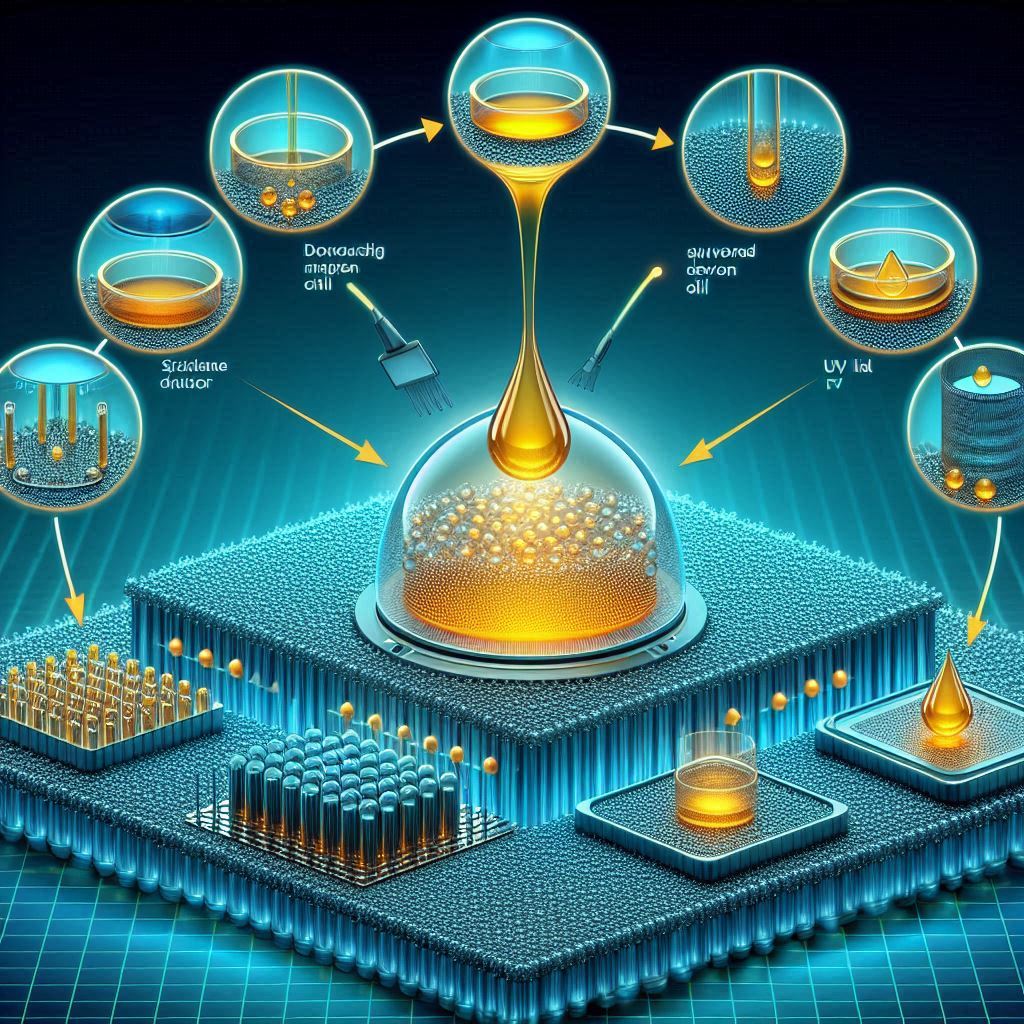
The end result of this liquid manufacturing process is an artificial compound eye with a viewing angle of 149 degrees, closely resembling that of the mosquito eye. This wide-angle capability is essential for applications requiring extensive visual coverage, such as in robotics and advanced imaging systems.
Multifunctional Compound Lenses Inspired by Mosquito’s Eyes
Technical Breakdown
The technical aspects of the liquid manufacturing process are integral to its success. The microlenses, coated with oil droplets, focus light with precision, while the silica nanoparticles enhance durability and functionality. By arranging the microlenses in a specific configuration and curing them with UV light, researchers create a lens system that not only replicates the structural complexity of natural compound eyes but also incorporates advanced features like anti-fogging properties.
Anti-Fogging Properties
One of the primary challenges in optical lens design is maintaining clarity in varying environmental conditions. Traditional lenses often suffer from fogging, which can obscure vision and impair performance. The incorporation of anti-fogging technology in this manufacturing process addresses this issue effectively. The silica nanoparticles create a moisture-repellent surface, ensuring that the lenses remain clear and functional even in high-humidity environments. This feature is particularly valuable for robotics and imaging technologies, where consistent performance is crucial.
3D Imaging Artificial Compound Eyes
Luke Lee’s Research
In another significant advancement, Luke Lee and his research team at the University of California have developed 3D polymer structures that emulate the structure of insect compound eyes. This innovative approach involves creating artificial compound eyes using 3D polymer printing techniques. The resulting structures consist of individual “ommatidia” or lenses arranged in a dome shape, mirroring the natural arrangement found in insect eyes.
The design of these artificial eyes includes several key components:
- Refractive Polymer Micro-Lenses: Each ommatidium features a refractive polymer micro-lens that captures and focuses light. This component is crucial for achieving high-resolution imaging and is designed to replicate the light-gathering capabilities of natural lenses.
- Light-Guiding Polymer Cones: A light-guiding polymer cone directs the captured light towards a waveguide behind each micro-lens. This setup enhances light transmission efficiency and helps channel the light to the photodetector.
- Waveguide and Optoelectronics Detector: The waveguide directs the light to an optoelectronics detector, which is responsible for recognizing and processing the image. This combination allows the artificial compound eye to generate detailed and accurate visual information.
Ommatidia and Dome Shape
The 3D polymer structures developed by Luke Lee’s team are arranged in a dome shape, similar to the structure of natural compound eyes. This configuration allows the lenses to capture light from all directions, providing a comprehensive field of view. The dome shape is critical for achieving a wide-angle vision, as it mimics the natural arrangement of ommatidia in insect eyes. This design ensures that light is efficiently guided to the photodetector arrays, enhancing the overall imaging capability of the system.
Potential Applications
The 3D imaging artificial compound eyes developed by Luke Lee and his team hold promise for a wide range of applications:
- High-Tech Cameras: The high-resolution, wide-angle capabilities of these artificial eyes make them ideal for advanced camera systems, capable of capturing detailed images with a broad field of view.
- Navigation Devices: In unmanned vehicles and drones, these artificial eyes could improve situational awareness by providing a comprehensive visual perspective.
- Synthetic Retinal Implants: For medical applications, synthetic retinal implants utilizing these artificial eyes could offer new possibilities for vision restoration and enhancement.
- Surveillance Sensors: The wide field of view and high-resolution imaging make these artificial eyes suitable for surveillance sensors, providing comprehensive monitoring capabilities.
- Medical Imaging: Smaller versions of these sensors could be used for internal medical imaging, such as examining the digestive tract, offering valuable insights into internal health.
Overall, the innovations in artificial compound eyes represent a significant leap forward in optical engineering, combining inspiration from nature with advanced technology to create systems with unprecedented capabilities.
Breakthrough at Hong Kong University of Science and Technology
The Electronic Compound Eye Design
Innovative Approach
A team of engineers and roboticists at Hong Kong University of Science and Technology has made significant strides in developing an electronic compound eye design. Their approach overcomes the challenge of affixing flat lenses onto a curved surface. Instead, they used a plastic hemisphere with multiple pinholes drilled through its surface to allow light to enter. Each pinhole is filled with a perovskite nanowire that directs light onto an individual light sensor. This design simplifies the manufacturing process and reduces costs while providing effective visual capabilities.
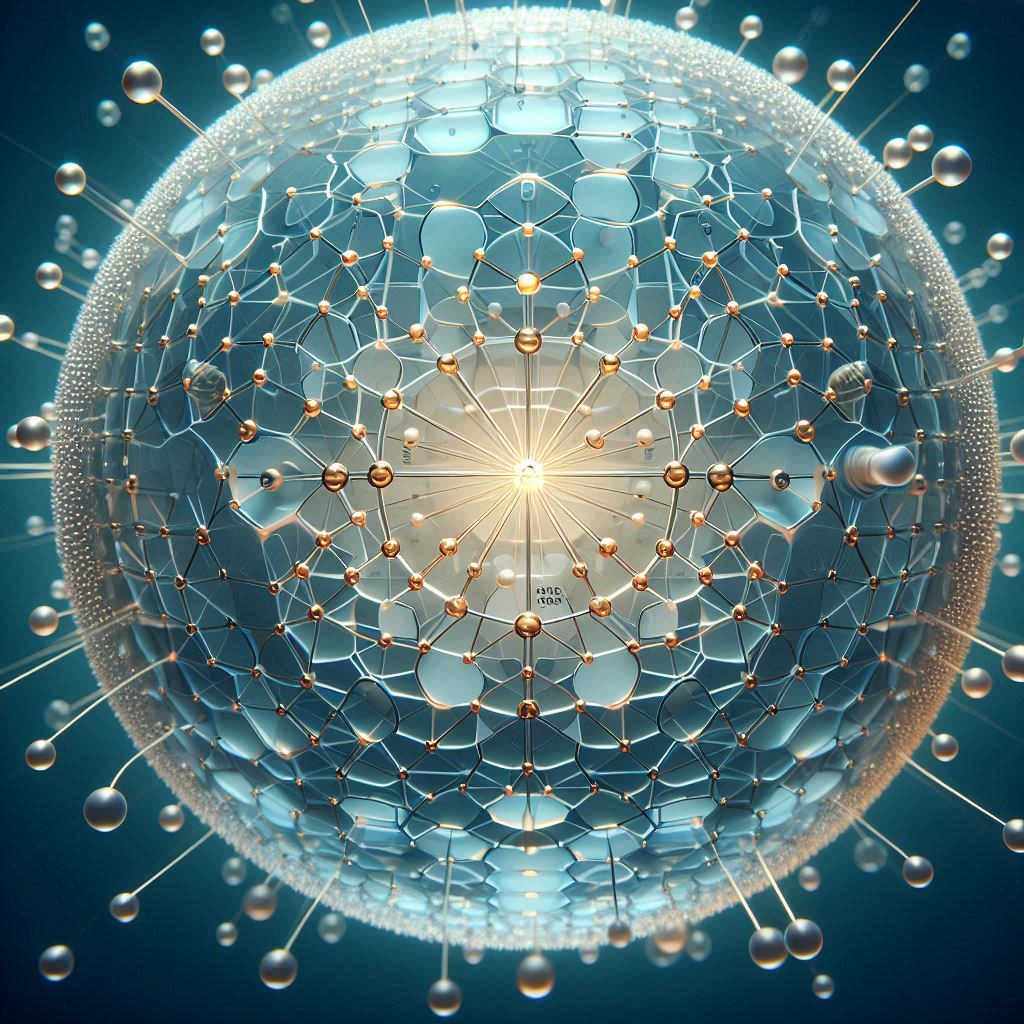
Technical Innovation
The use of a plastic hemisphere and perovskite nanowires represents a novel approach in electronic compound eye design. The pinholes in the hemisphere allow light to enter from various angles, and the perovskite nanowires direct this light onto sensors, which then process the images. This setup provides a field of view of 140 degrees, and when paired with another similar eye, the field increases to 220 degrees. This design allows for an inexpensive yet effective electronic eye suitable for various robotic applications.
Cost-Effectiveness
One of the primary advantages of this design is its cost-effectiveness. Traditional camera systems can be expensive, but the electronic compound eye developed by the Hong Kong team offers a more affordable alternative. By simplifying the manufacturing process and using cost-effective materials, this design makes advanced visual systems accessible for a broader range of applications, including swarm robotics and autonomous vehicles.
Real-World Testing
Drone Implementation
The research team installed a pair of electronic compound eyes on a flying drone to test their design. This setup was used to track the movements of a four-legged walking robot, demonstrating the eye’s capability to provide real-time, wide-angle vision. The results of these tests highlighted the effectiveness of the design in practical applications, showcasing its potential for enhancing robotic vision systems.
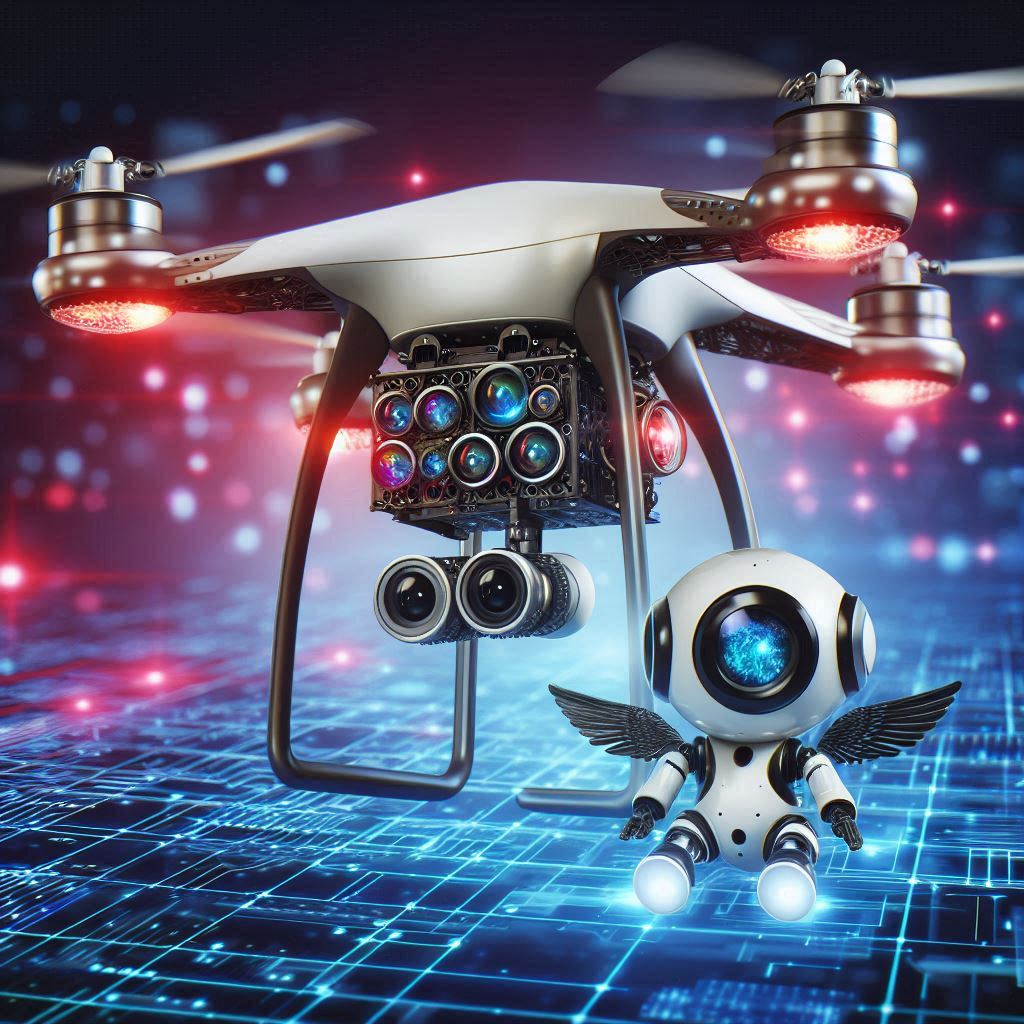
Swarming Robots
The electronic compound eyes developed by the Hong Kong team are particularly well-suited for swarm robotics. The ability to capture a wide field of view with multiple sensors enables robots to operate efficiently as a group, coordinating their movements and sharing visual information. This capability is crucial for autonomous vehicles and robotic systems that need to navigate complex environments or work together in coordinated tasks.
Future Prospects and Applications
Surveillance and Security
Artificial compound eyes hold significant potential for expanding surveillance and security applications. Their ability to provide 360° real-time monitoring could revolutionize security systems, offering comprehensive coverage and reducing blind spots. This capability is valuable for both public and private security, enhancing the effectiveness of monitoring systems in various environments.
Medical Advancements
In the medical field, smaller versions of artificial compound eyes could be used for internal imaging, such as examining the digestive tract or other internal organs. These sensors could provide detailed and real-time images, aiding in diagnostics and treatment planning. The integration of artificial compound eyes into medical devices represents a significant advancement in medical imaging technology.
Robotic Vision
The advancements in artificial compound eyes also promise to enhance robotic vision across various industries. From autonomous vehicles that require advanced navigation systems to industrial robots that need precise visual feedback, the applications of these technologies are vast.
Ethical and Practical Considerations
Discussion on the Ethical Implications of Advanced Surveillance
As with any transformative technology, the advancements in artificial compound eyes bring with them a range of ethical considerations. The potential for widespread surveillance capabilities raises concerns about privacy and data security. While these technologies offer benefits such as enhanced security and better monitoring systems, they also pose risks if not managed responsibly. It’s essential to strike a balance between leveraging these advancements for societal benefits and safeguarding individual privacy. The discussion around the ethical use of such technologies will be crucial in shaping their integration into everyday life.
Future Challenges
Addressing the technical and ethical challenges associated with artificial compound eyes will be key to their successful deployment. From a technical perspective, researchers must continue to refine the accuracy, durability, and functionality of these systems. Challenges such as ensuring consistent performance in varying environmental conditions and achieving high-resolution imaging across the entire field of view need ongoing attention.
On the ethical front, developing robust frameworks for data protection and privacy will be vital. Ensuring that these technologies are used responsibly and with transparency will help mitigate concerns and build public trust. Collaborative efforts among technologists, policymakers, and ethicists will be necessary to navigate these challenges effectively.
Conclusion
In summary, the evolution of artificial compound eyes represents a significant leap forward in the field of robotics and technology. Drawing inspiration from the remarkable visual systems of insects, researchers have developed innovative solutions that address both the design challenges and the practical applications of these systems. From liquid manufacturing processes to 3D polymer structures and electronic compound eyes, each advancement brings us closer to replicating the sophisticated capabilities of natural compound eyes in artificial systems.
Call to Action
As we continue to explore and develop these technologies, readers need to stay informed about the latest advancements in robotics and biomimetic technologies. Keeping abreast of new developments will not only enhance our understanding but also highlight the potential implications and applications of these technologies in various fields.
The future of technology lies in the fusion of nature’s wisdom with human ingenuity. Artificial compound eyes are a testament to how observing and understanding the natural world can lead to groundbreaking innovations. As we continue to push the boundaries of what is possible, these advancements remind us of the incredible potential that lies in drawing inspiration from the simplest and most sophisticated creatures on Earth.
Explore other interesting Articles:





